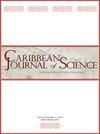西印度群岛格林纳达入侵狮子鱼(Pterois volitans)组胺毒性和金属矿物污染物的发生
IF 0.5
4区 生物学
Q4 BIODIVERSITY CONSERVATION
引用次数: 0
摘要
在加勒比海有针对性地捕捞入侵狮子鱼(Pterois volitans和P. miles)为监测狮子鱼的食品安全提供了机会,并检查了它们作为环境哨兵物种的效用。本研究的目的是评估狮子鱼组胺毒性(鲭鱼中毒),并量化西印度群岛格林纳达狮子鱼的矿物质和重金属污染物。热应激后狮子鱼肌肉中的组胺浓度显著增加,但仍低于食用的最大允许浓度。采用电感耦合等离子体质谱法对来自两个独立珊瑚礁系统的狮子鱼的肌肉和肝脏中的矿物质和重金属浓度进行了检测。博斯礁鱼类肝脏中的总砷含量明显高于哈利法克斯港的鱼类,但没有临床意义。铅、汞、镉、铜、钼和钴均低于分析仪的检测极限。在肌肉和/或肝组织中检测到预期浓度的铊、硒、铁、锌和锰。狮子鱼具有较低的组胺毒性风险,在格林纳达没有生物积累大量重金属,不会构成食品安全风险。博斯礁较高的砷浓度表明,未来应该对该地点进行监测和研究。狮子鱼作为重金属生物指标的潜力尚不确定,需要进一步验证。本文章由计算机程序翻译,如有差异,请以英文原文为准。
Occurrence of Histamine Toxicity and Metal and Mineral Contaminants in Invasive Lionfish (Pterois volitans) in Grenada, West Indies
Abstract Targeted fishing of invasive lionfish (Pterois volitans and P. miles) in the Caribbean creates an opportunity to monitor lionfish for food safety and to examine their utility as environmental sentinel species. The goals of this study were to assess P. volitans for histamine toxicity (scombroid poisoning) and to quantify mineral and heavy metal contaminants in lionfish in Grenada, West Indies. Histamine concentrations in lionfish muscle significantly increased after heat stress but remained below maximum allowable concentrations for consumption. Mineral and heavy metal concentrations were tested in muscle and liver from lionfish from two separate reef systems using inductively coupled plasma–mass spectrometry. Total arsenic levels in liver were significantly higher in fish sampled from Boss's Reef than those from Halifax Harbor, but they were not interpreted as clinically significant. Lead, mercury, cadmium, copper, molybdenum, and cobalt were below the detectable limit of the analyzer. Thallium, selenium, iron, zinc, and manganese were detected in muscle and/or liver tissue at expected concentrations. Lionfish represent a low risk for histamine toxicity and have not bioaccumulated significant heavy metals in Grenada to pose a food safety risk. The higher arsenic concentrations in Boss's Reef suggest that the location should be monitored and studied in the future. The potential for lionfish to act as bioindicators for heavy metals is uncertain and needs further validation.
求助全文
通过发布文献求助,成功后即可免费获取论文全文。
去求助
来源期刊

Caribbean Journal of Science
综合性期刊-生物多样性保护
CiteScore
1.00
自引率
25.00%
发文量
21
审稿时长
>12 weeks
期刊介绍:
The Caribbean Journal of Science publishes articles, research notes, and book reviews pertinent to natural science of the Caribbean region. The emphasis is on botany, zoology, ecology, conservation biology and management, geology, archaeology, and paleontology. The mission as a nonprofit scholarly journal is to publish quality, peer-reviewed papers and to make them widely available.
 求助内容:
求助内容: 应助结果提醒方式:
应助结果提醒方式:


